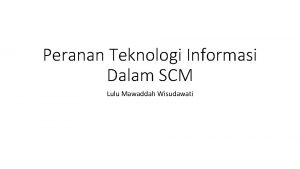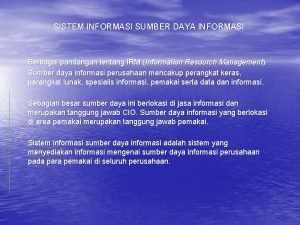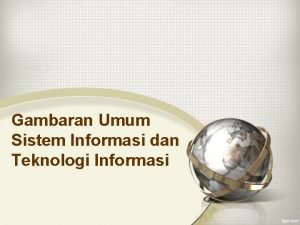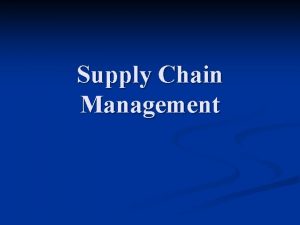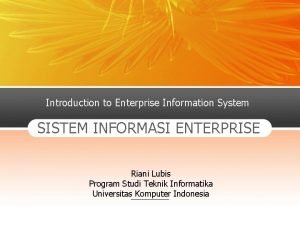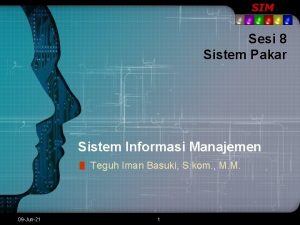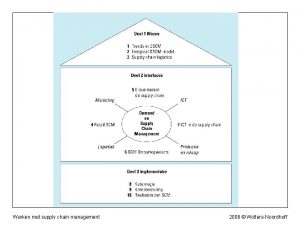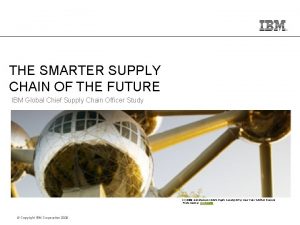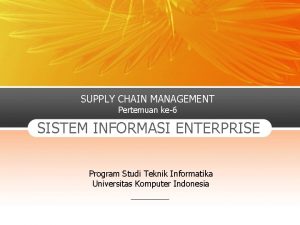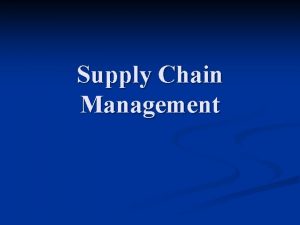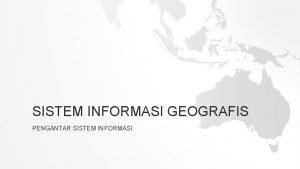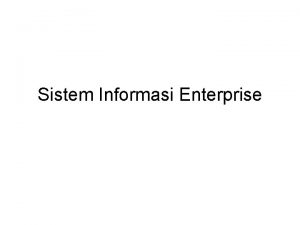SUPPLY CHAIN MANAGEMENT Pertemuan ke6 SISTEM INFORMASI ENTERPRISE












- Slides: 12

SUPPLY CHAIN MANAGEMENT Pertemuan ke-6 SISTEM INFORMASI ENTERPRISE Program Studi Teknik Informatika Universitas Komputer Indonesia

What is a Supply Chain? • The network of external suppliers, internal processes, and external distributors, and the links connecting them, that deliver a finished product or service to the customer. • The system of suppliers, manufacturers, transportation, distributors, and vendors that exists to transform raw materials to final products and supply those products to customers. RNL - 2014

Defining SCM is : • The process of effectively managing the components of an extended value chain--from suppliers, through manufacturing and distribution chain, and to the consumers. • The coordination of all supply activities of an organization from its suppliers and partners to its customers. • The integration of the activities that procure materials and services, transform them into intermediate goods and the final product, and deliver them to customers. • The integration of business processes from end user through original suppliers, that provide products, services, and information that add value for customers. RNL - 2014

SCM • The management of all activities and processes related to both upstream vendors and downstream customers in the value chain • Tracking and managing demand, inventory, and delivery • Procurement and vendor relationship management • Technology enabled • Upstream supply chain ; Transactions between an organization and its suppliers and intermediaries, equivalent to buy-side e-commerce. • Downstream supply chain ; Transactions between an organization and its customers and intermediaries, equivalent to sell-side e-commerce. RNL - 2014

The Goal of SCM • Supply chain management is concerned with the efficient integration of suppliers, factories, warehouses and stores so that merchandise is produced and distributed: • In the right quantities • To the right locations • At the right time • In order to • Minimize total system cost • Satisfy customer service requirements RNL - 2014

Supply Chain Supplier Manufacturer Distributor Retailer Customers

Ex : Dairy Products Supply Chain RNL - 2014

Flows in a Supply Chain Cash Products and Services Information N-Tier Suppliers Manufacturers Supply Side Internal Demand Supply RNL - 2014 Distributors Retailers Demand Side

Approaches to SCM • In Push systems, work release is based on downstream demand forecasts – Keeps inventory to meet actual demand – Acts proactively • In Pull systems, work release is based on actual demand or the actual status of the downstream customers – May cause long delivery lead times – Acts reactively RNL - 2014

Push Approach to SCM RNL - 2014

Pull Approach to SCM RNL - 2014

Supply Chain Processes RNL - 2014
 Lulu scm
Lulu scm Sumber daya informasi
Sumber daya informasi Contoh sistem informasi dan teknologi informasi
Contoh sistem informasi dan teknologi informasi What is crm in supply chain management
What is crm in supply chain management Contemporary management theory ppt
Contemporary management theory ppt Supply chain management system
Supply chain management system Sistem informasi enterprise
Sistem informasi enterprise Matching supply and demand in supply chain
Matching supply and demand in supply chain Difference between logistics and supply chain
Difference between logistics and supply chain Food chain sequence
Food chain sequence Sistem pakar dalam sistem informasi manajemen
Sistem pakar dalam sistem informasi manajemen Werken met supply chain management noordhoff
Werken met supply chain management noordhoff Ibm smart supply chain
Ibm smart supply chain
